The Italians are a nation of mycophiles, pouring into woods and forests in their thousands each autumn on the hunt for chiodini, gallinacci and, most prized of all, porcini, to saute, preserve or, as here, turn into a richly flavoured sauce. As well as having an earthy character that comes from a life spent largely underground, mushrooms are high in monosodium glutamate, the same thing that gives parmesan and ripe tomatoes their intensely savoury quality, which makes them an ideal base for a meat-free ragu. But do you need to be out foraging at dawn for the best results, or can you achieve fungi nirvana with supermarket produce?
The mushrooms
The Venetian refugee Giacomo Castelvetro wrote in his 1614 treatise The Fruit, Herbs and Vegetables of Italy that although wild mushrooms are “as abundant here in England as they are in Italy … few people seem to know much about them”. Plus ça change, as they don’t say in Rome. At this time of year, wild mushrooms are available in specialist greengrocers and online, but most English-language recipes acknowledge the fact that readers are unlikely to be able to get hold of them for all but the briefest window, so helpfully suggest substitutes.
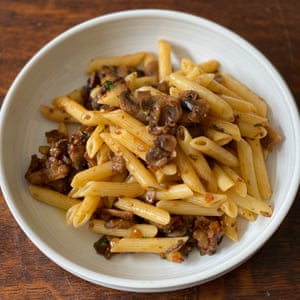
The late Marcella Hazan, the grande dame of Italian food writing in the US, writes in Marcella Cucina that “when working with cultivated mushrooms, I try to find methods that will excite from them flavour reminiscent of boletus [porcini]”. One of them, from Marcella’s Italian Kitchen, involves using a mixture of white mushrooms and dried porcini, while a later development combines white mushrooms and fresh shiitake, on the basis that “the exchange of flavour that takes place between the two varieties produces such a remarkable evocation of the aroma that one looks for in boletus that, as long as I have shiitake, I am more peacefully resigned to the absence of fresh porcini from American markets”.
Indeed, it is remarkable how much flavour one can coach into a standard white mushroom, not only by adding dried porcini and, more importantly, their soaking liquid, but also by evaporating most of the liquid (mushrooms are 80% to 90% water) in a hot frying pan to concentrate their flavour. Better still in terms of flavour and texture are the chestnut mushrooms used by Anna Del Conte and the America’s Test Kitchen team, although my testers prefer the dried porcini in Hazan’s first recipe to her shiitake version, for their depth of flavour and their texture.
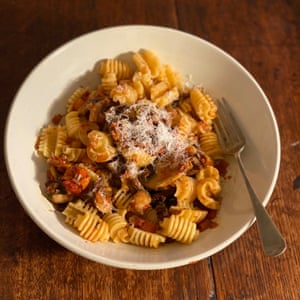
Angela Hartnett’s mushroom ragu, from her book Cucina, uses dried mushrooms alone, but while it packs a fairly intense punch, we miss the juiciness of fresh funghi – and not everyone is keen on the consistency of rehydrated mushrooms.
A clever way of getting the flavour without any of the textural risk is to grind the dried porcini to a “magical mushroom dust” before use, as Yotam Ottolenghi and Ixta Belfrage suggest in their new book, Flavour. This can then be made into a seriously flavourful paste, but have a taste before use; if your porcini were gritty to start with, you may want to strain the paste, although generally I don’t bother. If you don’t have the means, or patience, to grind dried mushrooms, soak them in the equivalent volume of warm water for 20 minutes, then chop and add the mushrooms and their soaking water to the pan instead.
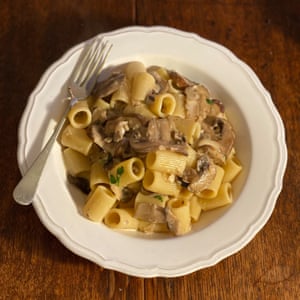
The aromatics
Every recipe I try starts off by sauteing chopped onion (or shallots, in the case of ATK, as it will henceforth be known), with Del Conte and Hartnett then adding diced carrot and celery to create a soffritto, a base that gives their sauces depth and substance. Del Conte doesn’t add garlic, but it goes so well with mushrooms that, like Hazan, Hartnett, Valentina Harris and ATK, I am sold. The peppery flavour of Hartnett and ATK’s thyme is also popular, but rosemary feels as if it has the potential to overpower the mushrooms.
Ottolenghi and Belfrage, whose recipe is for a meatless ragu rather than a mushroom sauce, stir in cumin and rose harissa, which lend an earthy spice and gentle heat that works very well, especially with the addition of lentils and pearl barley to bulk it out. If you are after a vegetarian pasta sauce to give a ragù bolognese a run for its money, this is it.
Umami boosters
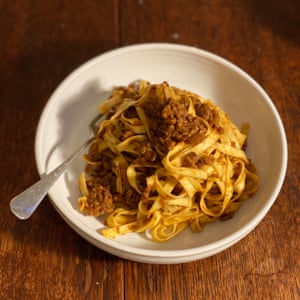
The dishes that prove the most popular enhance the mushroom’s umami with other ingredients that are naturally rich in the stuff – often tomatoes, be they fresh, tinned or pureed. We tend towards the tinned variety, because, once reduced, as in Hazan’s recipe, they seem to supply a certain sweetness that works very well with the savoury mushrooms.
We are also big fans of Hazan’s anchovies, which melt into the sauce while packing a real saline punch, but I would prefer to keep this sauce vegetarian, so I am not going to use them in my final dish. If you like the sound of it, check out the recipe for penne col sugo di funghi coltivati in Marcella’s Italian Kitchen.
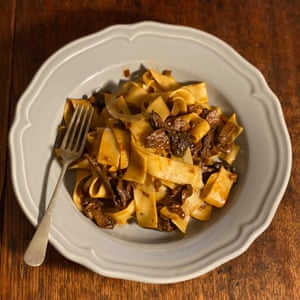
Ottolenghi and Belfrage add white miso and soy sauce, serious umami bombs that, like Marmite, are well worth deploying in many meat-free situations. In this case, though, the porcini paste renders them unnecessary. Do bear them in mind if you taste yours and find it underpowered, however; simply stir in to taste.
The liquid
The chicken stock in the ATK recipe will add umami, too, as will the white wine used by Del Conte, Hartnett and Hazan, especially if you go for something particularly savoury, such as fino sherry. Again, the porcini broth means there is no need for stock, but wine always adds complexity – and is also nice to drink while you are cooking, if you are that way inclined, so for me it makes the cut.
ATK takes a different tack from the other recipes and uses cream rather than tomatoes, which makes for a rich, garlicky dish in which the mushrooms are just one of many savoury elements, along with liberal amounts of parmesan. If this is the kind of sauce you are looking for, I strongly recommend it.
Even if you go down the tomato and porcini route, however, it cries out for a dash of olive oil and a dusting of grated cheese (more umami) at the end.
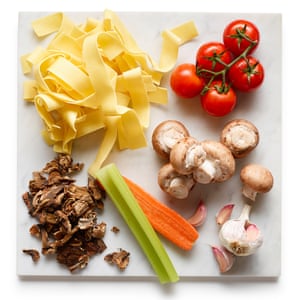
The pasta
First, though, you will need to select a pasta (this sauce would also work with polenta). Penne is the most popular choice, suggested by Del Conte and Hazan, with the latter also mentioning garganelli or radiatori. ATK recommends campanelli or farfalle, while Harris suggests pappardelle, tagliatelle or fettuccine; Ottolenghi and Belfrage don’t specify, but the picture in their book seems to show their ragu tossed with fresh tagliatelle, which is also the choice of The Silver Spoon. Clearly, it is a matter of preference, but such a chunky sauce seems lost on penne and radiatori, where the openings are too small to allow much ingress. I prefer longer shapes – tagliatelle or pappardelle – and fresh, too, to match the richness of the sauce. But use whatever you have handy: the sauce is the star here.
Perfect pasta ai funghi
Prep 15 min
Cook 30 min
Serves 2 (easily doubled)
20g dried porcini
1 tbsp olive oil
1 tbsp butter (or 1 extra tbsp olive oil)
½ onion, peeled and finely diced
½ carrot, diced
½ stick celery, diced
2 garlic cloves, peeled and crushed
2 sprigs fresh thyme, leaves picked
250g chestnut mushrooms, cut into thin, roughly ½cm-thick slices
100g chopped tomatoes
3 tbsp dry sherry or white wine
200g pasta (I like fresh tagliatelle or pappardelle here)
Extra-virgin olive oil and finely grated parmesan, to serve (both optional)
Blitz the porcini to a powder in a spice grinder or food processor, then stir into a bowl filled with 100ml hot water, to make a paste. Leave to infuse.
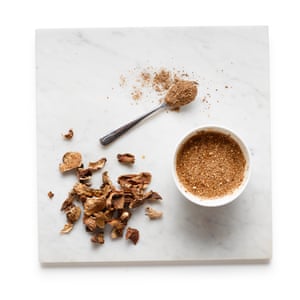
Heat the oil and butter in a wide pan over a medium-low heat and fry the onion until golden and translucent.
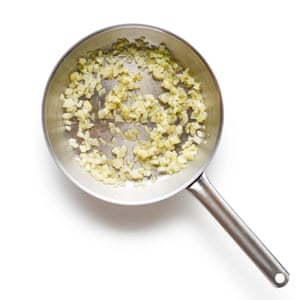
Add the carrot and celery, fry until softened, stirring regularly, then add the garlic and thyme and fry for another 30 seconds.
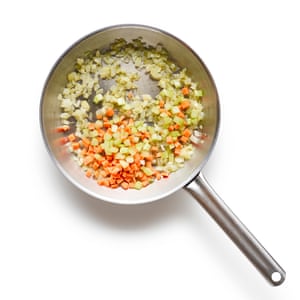
Turn up the heat, add the fresh mushrooms and fry, stirring regularly, until they have slumped, browned and no longer give off steam. Add the sherry or wine, sizzle until most of the liquid has evaporated, then add the tomatoes and the porcini paste (taste it first: if it is unpleasantly gritty, dilute it slightly, then strain) and stir well.
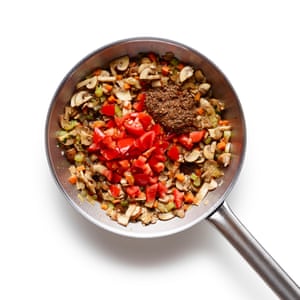
Bring to a simmer, then turn down the heat, cover and leave to cook gently for about 10 minutes, until thick.
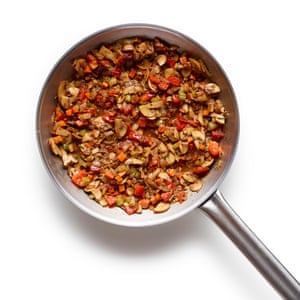
In the meantime, cook the pasta in plenty of well-salted boiling water, according to the packet instructions.
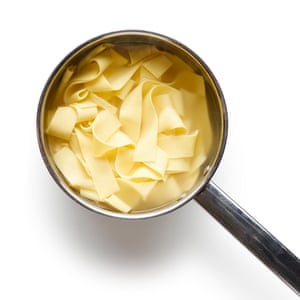
Season the sauce to taste, then drain the pasta, saving a little of the water. Put the pasta into the pan with the sauce and toss well to coat, adding a splash or two of the reserved cooking water if the sauce seems too thick to coat the pasta evenly. Finish with a drizzle of extra-virgin olive oil and serve with grated parmesan or similar.
• Pasta ai funghi: which mushrooms do you favour and how do you prepare them? And why don’t we make more of them in the UK?
The Link LonkSeptember 30, 2020 at 06:00PM
https://ift.tt/3jbTjbz
How to make the perfect pasta ai funghi – recipe - The Guardian
https://ift.tt/31oM9uv
Pasta
No comments:
Post a Comment